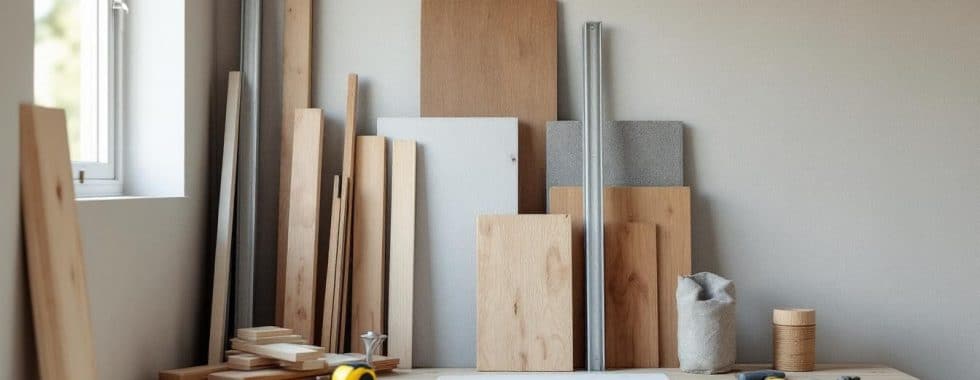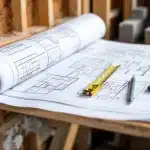How to Extend Your Home on a Budget
At Cameron Construction, we understand the desire to expand your living space without breaking the bank.
A low-cost house extension can transform your home and add value to your property.
In this guide, we’ll share practical strategies to help you plan and execute a budget-friendly home expansion project.
Let’s explore how you can make your dream extension a reality without overspending.
How to Plan a Budget-Friendly Home Extension
Assess Your Needs and Space
Start by defining why you need an extension. Do you want an extra bedroom, a larger kitchen, or a home office? Understanding your specific needs helps prioritise your spending.
Next, evaluate your available space. Measure your property and identify potential areas for expansion. Consider factors like sunlight, views, and privacy. Creative use of existing space can often be more cost-effective than building outwards.
Navigate Building Regulations
Building regulations can significantly impact your extension plans and budget. Research local council requirements early in the process. Some areas have strict rules about extension size, height, or design.
Contact your local council or a building surveyor for guidance. They can provide information on necessary permits and potential restrictions. This step can prevent costly design changes later.
Set a Realistic Budget
Develop a realistic budget for a successful extension project. Get quotes from multiple builders to understand current market rates. Recent data shows the average cost for a standard ground floor extension in Melbourne ranges from $2,500 to $4,000 per square metre.
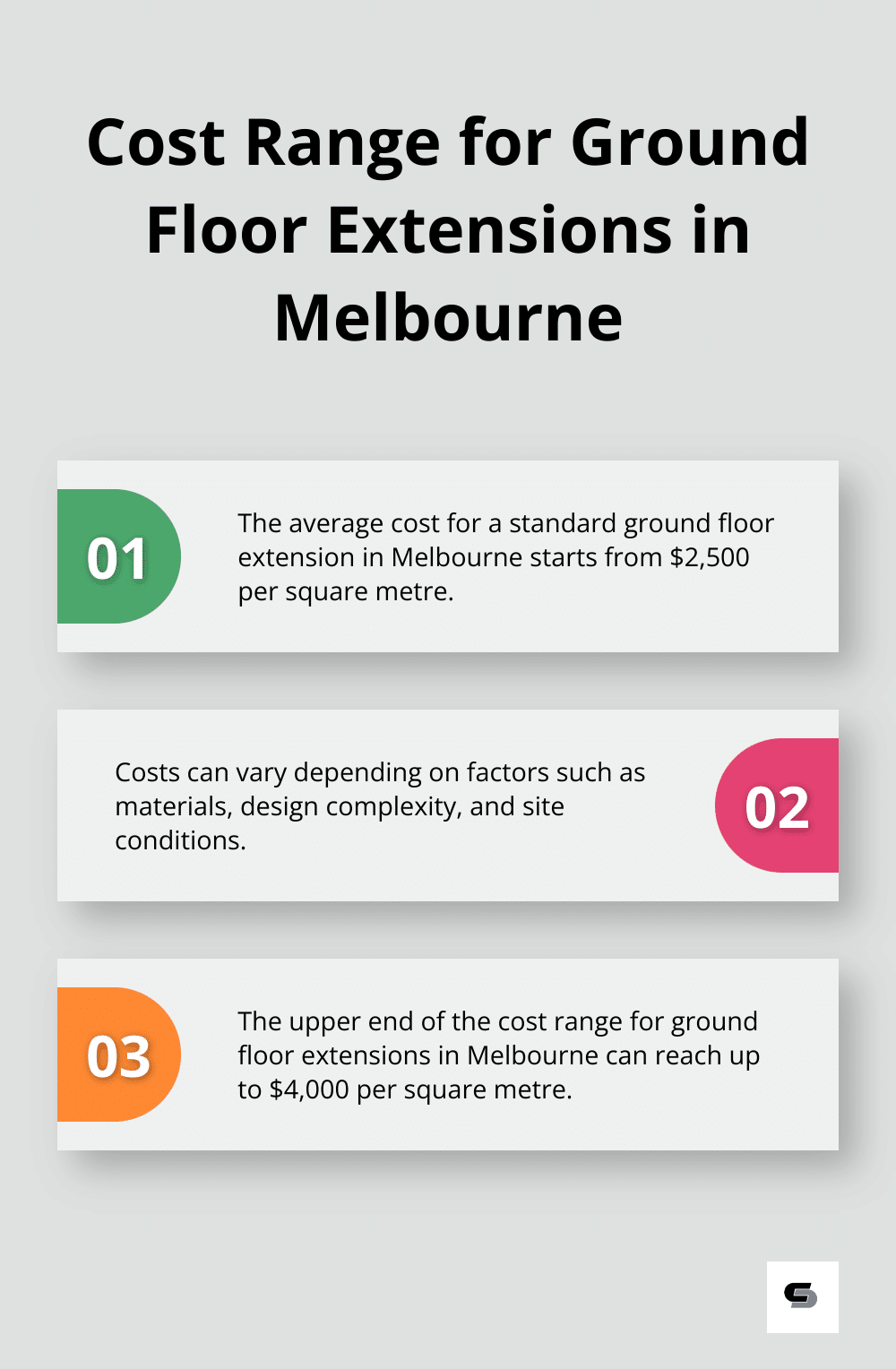
Include additional costs like design fees, council permits, and potential contingencies. Allocate 10-15% of your total budget for unexpected expenses (this buffer can be a lifesaver during the project).
Create a Practical Timeline
A well-planned timeline can manage costs by avoiding delays and rushed decisions. Consider factors like permit approval times, which can take several weeks or even months.
Break your project into phases:
- Design and planning
- Approvals
- Construction
- Finishing touches
Be realistic about timeframes – rushing can lead to mistakes and additional costs.
Prioritise and Compromise
List your must-haves and nice-to-haves for the extension. This helps you focus your budget on essential elements while identifying areas where you can compromise or save.
You might prioritise high-quality insulation for long-term energy savings but opt for more affordable flooring options. Some features can always be upgraded later when budget allows.
These steps will prepare you for your budget-friendly home extension journey. The next section will explore cost-effective extension strategies to maximise your investment and create the additional space you need without overstretching your finances.
Smart Strategies for Budget-Friendly Extensions
Embrace Single-Storey Extensions
Single-storey extensions offer a cost-effective solution compared to multi-level additions. They require less structural work and often have simpler approval processes. In Melbourne, house extension costs generally fall within the $260,000 to $350,000 range for ground floor and second storey extensions.
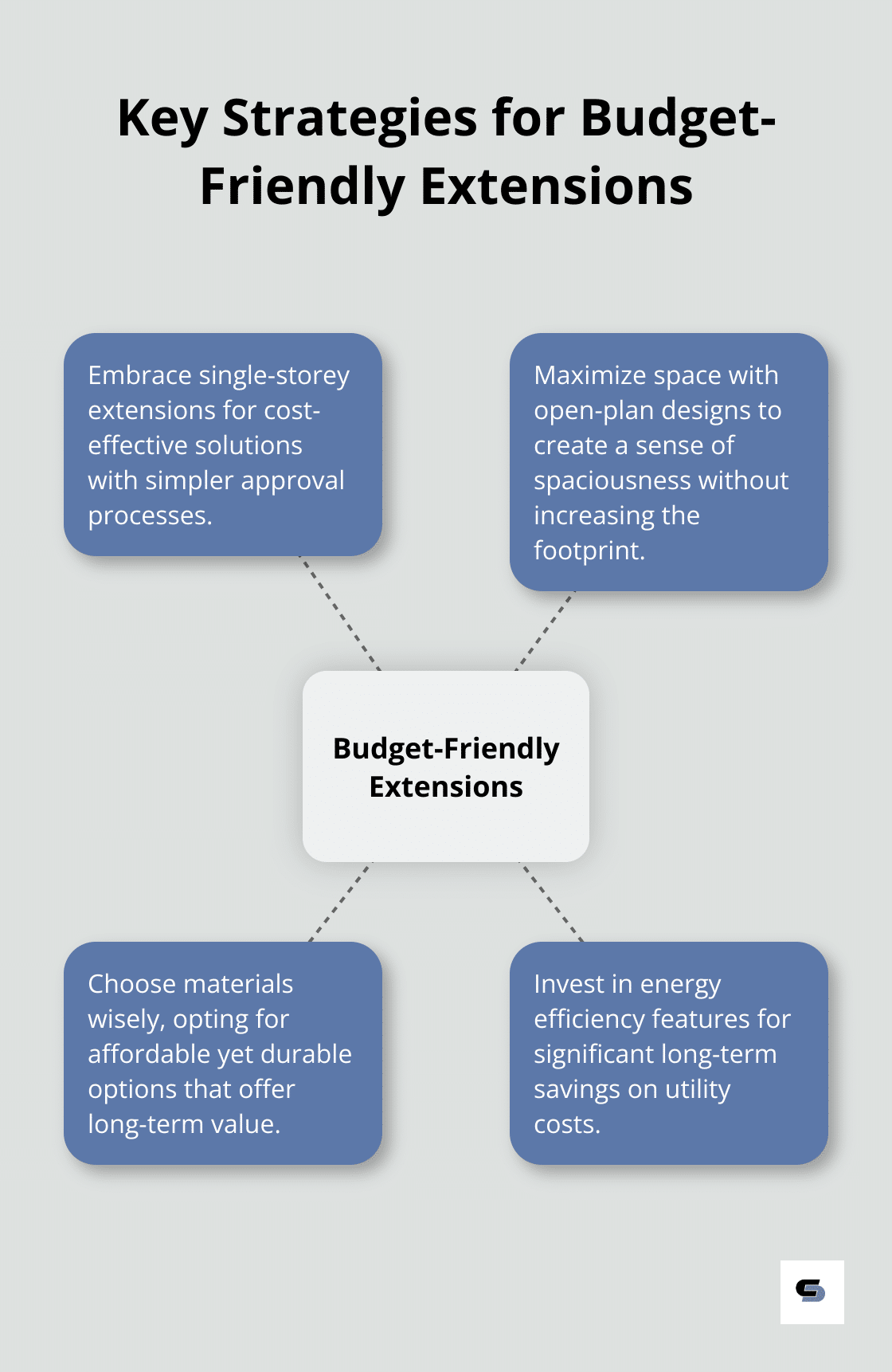
To maximise a single-storey extension, create multi-functional spaces. A kitchen-diner-living area can add significant value and functionality without the expense of multiple rooms.
Maximize Space with Open-Plan Designs
Open-plan layouts make your extension feel larger without increasing its footprint. Removing internal walls creates a sense of spaciousness and improves natural light flow. This approach can reduce construction costs and the need for additional windows or lighting.
When planning an open-plan extension, consider the placement of load-bearing walls (removing these can significantly increase costs). Work with a structural engineer to identify the most cost-effective way to achieve your desired layout.
Choose Materials Wisely
Material selection can make or break your budget. Opt for affordable yet durable options that offer long-term value. Vinyl flooring can mimic the look of hardwood at a fraction of the cost. Engineered wood provides a cost-effective alternative to solid timber.
For external cladding, fibre cement boards offer durability and style at a lower price point than brick or stone. They’re also easier to install, potentially reducing labour costs.
Don’t overlook recycled or second-hand materials. Architectural salvage yards often house unique, high-quality items at budget-friendly prices. Just ensure any second-hand materials meet current building standards.
Invest in Energy Efficiency
While some energy-efficient features may have higher upfront costs, they offer significant long-term savings. Energy-efficient windows help keep your home warmer in winter and cooler in summer by reducing heat transfer. This reduces your dependence on artificial climate control.
Proper insulation is essential. Invest in high-quality insulation for walls, floors, and ceilings. The initial cost is offset by reduced heating and cooling needs over time.
Consider passive solar design principles in your extension. Properly placed windows and thermal mass materials can harness natural heat in winter and keep your space cool in summer, reducing reliance on artificial climate control.
These strategies can help you create a beautiful, functional extension that adds value to your home without breaking the bank. The next section will explore how to balance DIY efforts with professional help to further optimise your budget.
Balancing DIY and Professional Work in Home Extensions
DIY Tasks for Cost Savings
Painting offers significant DIY savings. A typical room costs $300 to $800 when professionally painted, but you can complete it for under $200 in materials. Demolition work also cuts costs. Remove old fixtures or non-load-bearing walls yourself to save hundreds in labour costs.
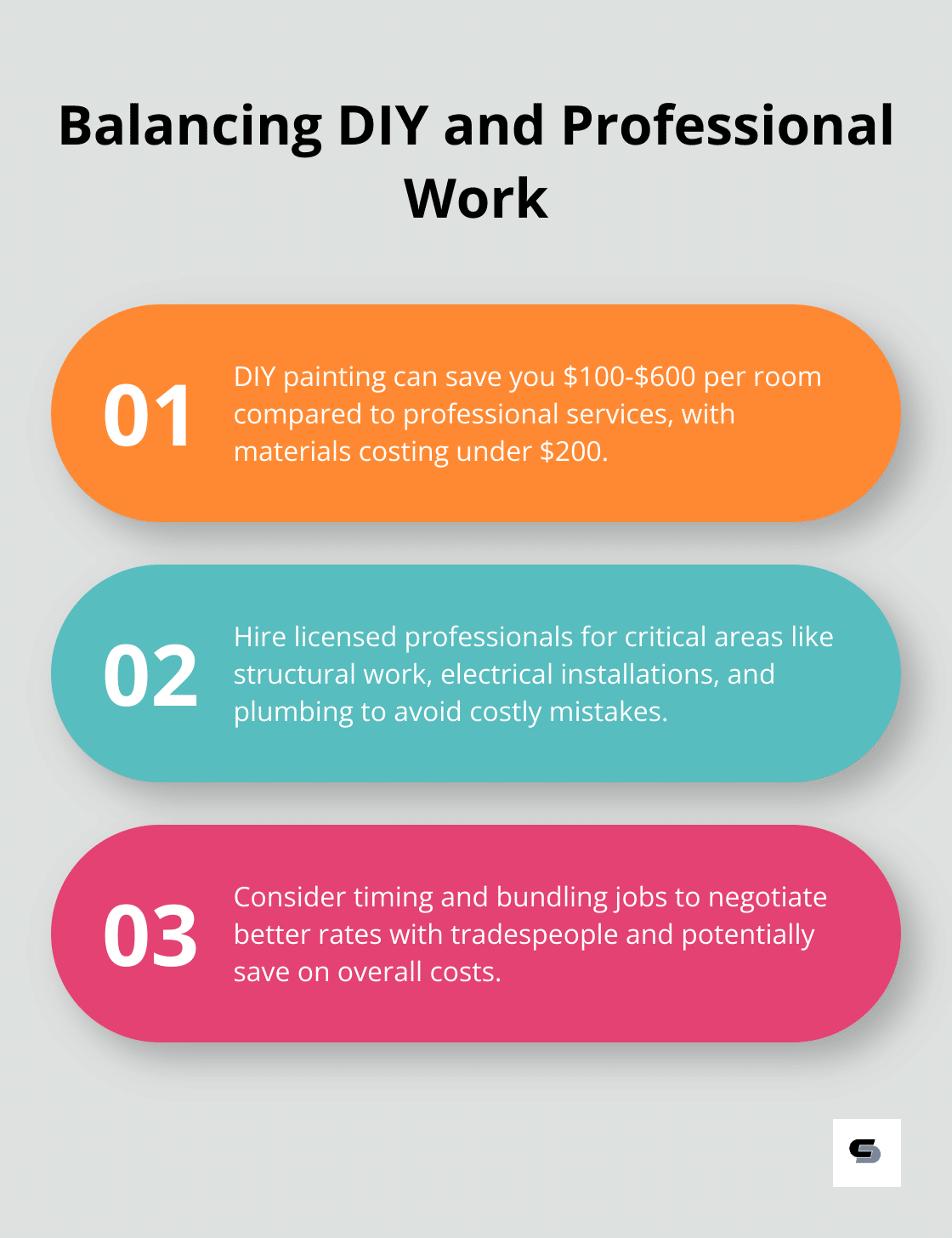
Landscaping and basic carpentry work (like building shelves or installing baseboards) suit DIY efforts. These tasks can save you $50 to $100 per hour in labour costs.
Professional Work for Critical Areas
Hire licensed professionals for structural work, electrical installations, and plumbing. The risks and long-term costs of DIY mistakes in these areas outweigh any initial savings. (In Australia, unlicensed electrical work is illegal and can void your home insurance.)
Complex tiling, especially in wet areas, often requires professional skills. While DIY tiling can save money, poor installation can lead to water damage, costing thousands to repair.
Finding Reliable and Affordable Contractors
Ask for recommendations from friends or family who’ve recently completed similar projects. Online platforms like HiPages or Oneflare can connect you with rated tradespeople.
Get at least three quotes for each job. This gives you a realistic price range and helps you spot any outliers. Don’t automatically choose the cheapest option – consider the contractor’s experience, references, and your rapport with them.
Negotiating Better Rates with Tradespeople
Timing affects your costs. Many tradespeople offer discounts during their off-peak seasons. For example, roofers might have more competitive rates in winter.
Consider bundling jobs together. If you need both electrical and plumbing work, some companies offer discounts for booking multiple services.
Be clear about your budget from the start. Many contractors will work with you to find cost-effective solutions if they know your financial constraints upfront.
The goal is to create a beautiful, functional space that adds value to your home (without cutting corners at the expense of the final result). If you’re unsure about balancing DIY and professional work, consider consulting with experienced companies like Cameron Construction. Their expertise can guide you in making informed decisions about your home extension project.
Final Thoughts
A low-cost house extension is achievable with careful planning and smart strategies. You can reduce expenses without compromising quality by opting for single-storey extensions, open-plan designs, and cost-effective materials. Energy-efficient features offer long-term savings that make them a wise investment for your project.
You can cut costs where possible while ensuring critical work meets high standards when you balance DIY tasks with professional expertise. Your dream of a larger, more functional living space is within reach. These budget-friendly strategies will help you transform your home without breaking the bank.
Start planning your extension today and take the first step towards creating the home you’ve always wanted. Cameron Construction offers expertise in home renovations and extensions in Melbourne (with over 40 years of experience). Their team can help you navigate the complexities of your project and ensure your vision becomes reality within your budget constraints.

